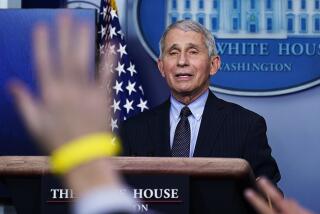International Squabble Rages Over Naming Newer Chemical Elements : Periodic Table: Drama involves sex discrimination, geographic illiteracy and political horse-trading.
A bitter international controversy has broken out over the time-honored right of discoverers to name their finds.
These aren’t explorers claiming new territory for the homeland. They’re an elite cadre of American and European scientists who seek out new elements, the chemical units that make up everything in the universe.
The evolving drama involves sex discrimination, geographic illiteracy and political horse-trading.
Names selected for the universal building blocks immortalize people and places in the periodic table of elements, a fixture in science classrooms and laboratories everywhere.
The table lists elements by their atomic numbers, symbols and weights. Hydrogen, the lightest natural element, is No. 1; uranium, the heaviest, is No. 92.
Winning a place in the table “is an honor greater than the Nobel Prize,” said Glenn T. Seaborg, a Nobel laureate at the Lawrence Berkeley Laboratory in California.
In 1951, Seaborg shared the prize in chemistry for discovering plutonium and nine other elements. In recognition of that work, scientists from Lawrence Berkeley and California’s Lawrence Livermore National Laboratory who discovered element 106 decided to name it “seaborgium.”
“A thousand years from now, seaborgium will still be in the periodic table,” Seaborg, now 83, said when the name was announced in March, 1994, “whereas the 20th-Century Nobel Prize winners will seem a very small part of history.”
But then came a rebuff from a commission of the International Union of Pure and Applied Chemistry, the group that reviews chemical names.
Along with other proposed changes, the commission recommended rejecting “seaborgium” and naming element 106 “rutherfordium” for British chemist Ernest Rutherford, who won the 1908 Nobel Prize.
A chorus of outrage ensued, perhaps best summarized by Albert Ghiorso, a senior scientist emeritus at Lawrence Berkeley and a co-discoverer of element 106.
“Ridiculous,” huffed Ghiorso, who co-discovered 12 elements between 1945 and 1974. Never before, he said, had undisputed discoverers of an element been denied the right to name it.
The controversy comes at a time of renewed interest in the periodic table.
After a 10-year lull in which no new elements were discovered, German scientists last year claimed discovery of two new elements within a few weeks.
In November, Peter Armbruster and his associates at GSI, the Heavy-Ion Research Laboratory in Darmstadt, announced discovery of element 110. In December, they announced No. 111.
The periodic table once consisted of only 92 elements, all natural substances, the most basic units of creation.
In 1940, the table began to expand when Seaborg and others used a cyclotron, or “atom smasher,” to create plutonium.
That led to a succession of other “transuranium” elements--those located beyond uranium in the periodic table. Researchers sometimes made competing claims of discovery.
Therein lie the roots of the current brouhaha.
Disputes arose after groups at Lawrence Berkeley, GSI and Russia’s Joint Institute for Nuclear Research, at Dubna, claimed discovery of elements 102 through 109 between 1958 and 1984.
Lawrence Berkeley and Dubna, as the Russian lab is known, battled over elements 102 through 106. The Russians wanted to name No. 104 “kurchatovium,” after Soviet physicist Igor V. Kurchatov. The Americans preferred “rutherfordium.”
The Americans wanted to name No. 105 “hahnium” after the German chemist Otto Hahn, while the Russians offered “nielsbohrium” after Danish physicist Niels Bohr. Likewise, teams at GSI and Dubna clashed over elements 107, 108 and 109.
In 1987, the combatants agreed to the scientific equivalent of binding arbitration. The world’s two great organizations in chemistry and physics--the International Union of Pure and Applied Chemistry and the International Union for Pure and Applied Physics--formed a panel to assign credit for the discoveries.
The panel’s decision, announced in 1992, gave Dubna sole credit for discovery of No. 102. Lawrence Berkeley and Dubna shared credit for Nos. 103, 104 and 105. Lawrence Berkeley got sole credit for 106.
With credit officially assigned, the two organizations submitted the names to a special commission of the International Union of Pure and Applied Chemistry; it consists of 20 chemists from 12 countries.
First, it eliminated seaborgium from consideration, ruling that no chemical element can be named after a living chemist.
Ghiorso retorted that his group had named element 99, einsteinium, and element 100, fermium, in 1952--while both Albert Einstein and Enrico Fermi were still alive.
In a bit of horse-trading, the commission chose names for elements 104 and 105 that were apparently intended to give Russian researchers more credit than Americans for their heavy-element research.
Element 104, the panel decided, would be named “dubnium,” honoring the home of Russia’s heavy-element research center.
For element 105, the commission chose”joliotium” (for French physicist Frederic Joliot-Curie), a name the Russians had wanted to use for a previous element.
Further outrage flared, especially among the Germans, when the commission rejected GSI’s name for element 108: “hassium,” the Latinized version of Hesse, home state of Germany’s heavy-element laboratory.
A geographically illiterate world, the commission reasoned, would never recognize the name. So it assigned No. 108 the name “hahnium,” for German physicist Otto Hahn.
A final resolution of the whole controversy is expected in August, when the International Union of Pure and Applied Chemistry’s governing council will consider the naming commission’s recommendations.






